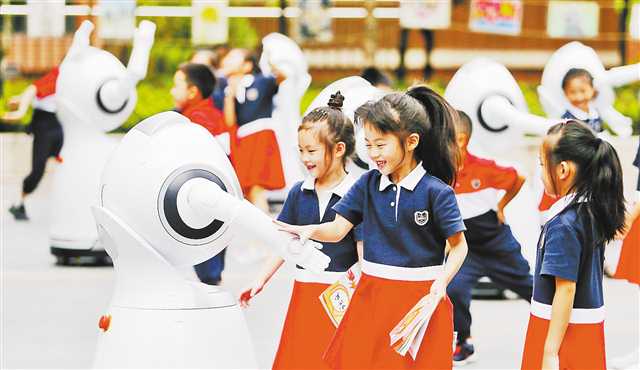Chongqing: Primary and secondary schools in Liangjiang New Area focus on promoting artificial intelligence education.

On September 6th, at Xinghu School in Liangjiang New Area, children were in close contact with the new intelligent robot teaching assistant. Reporter Bin Luo photo
Chongqing Daily News (Reporter Kuang Lina) On September 8, Chongqing Daily reporter learned from the Education Bureau of Liangjiang New District that the district has equipped 65 artificial intelligence robot classrooms for 42 primary and secondary schools and public kindergartens. Starting from this semester, artificial intelligence courses will be offered in primary and secondary schools.
"If you give him instructions, the puppy will blink, sing and wag its tail." On September 4th, Wang Xiaojiang, the information technology teacher of Xinghu School in Liangjiang New Area, demonstrated the operation mode of robot dog to the students, which attracted the students’ admiration. Zhang Xianbin, the principal of the school, said that starting from this semester, every grade of the school will offer artificial intelligence courses every week. Students can experience artificial intelligence technology (robot voice delivery, machine vision recognition, etc.) in the robot classroom and learn creative model building, graphical programming and robot action editing.
At present, Liangjiang New District has equipped 65 artificial intelligence robot classrooms and 215 excellent CRUZR robots for 42 primary and secondary schools and public kindergartens within its jurisdiction, and has carried out centralized training for 100 artificial intelligence robot course teachers, promoting Leju and 10 primary and secondary schools to jointly build an artificial intelligence maker laboratory, and carried out standard textbook programming teaching in primary and secondary schools.
"In the future, robots and all kinds of smart devices will enter thousands of households. Artificial intelligence programming will become an essential skill for people’s work and life just like using a computer. " The relevant person in charge of the Education Bureau of the district said that children exercise their thinking ability by learning programming and help them understand the digital world around them.
Liangjiang New Area will focus on promoting the construction of smart campus, and incorporate robot programming and STEAM courses into after-school service at 3: 30. All primary and secondary schools will start with the teaching of basic knowledge of artificial intelligence and educate students on artificial intelligence enlightenment; Let every student learn to deal with intelligent tools, so as to cultivate their basic literacy in the information age such as computational thinking and innovative thinking.
News link
In 2018, the Ministry of Education issued a notice of the Action Plan for Artificial Intelligence Innovation in Colleges and Universities, proposing to build 100 "Artificial Intelligence +X" composite specialties by 2020; Compile 50 international first-class undergraduate and postgraduate textbooks and build 50 national-level online open courses in the field of artificial intelligence; Establish 50 artificial intelligence colleges, research institutes or interdisciplinary research centers.
In September 2018, following Zhejiang, Beijing, Shandong, Jiangsu and other places, the Chongqing Municipal Education Commission issued the Notice on Strengthening Programming Education in Primary and Secondary Schools, clearly requiring that primary and secondary schools should offer programming education courses, with no less than 36 class hours in grades 3-6 of primary schools and no less than 36 class hours in junior high schools, and each primary and secondary school should be equipped with at least one full-time programming education teacher. The primary school stage is based on experience, and the programming ideas are felt through the forms of game teaching and project teaching. In junior high school, advanced programming language is used as a tool to link practical problem solving with algorithm thought. In high school, you need to master the basic knowledge of a programming language.